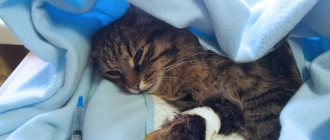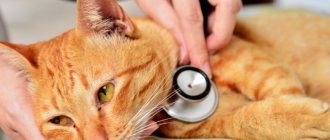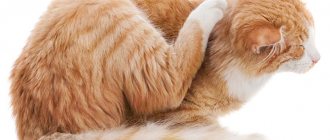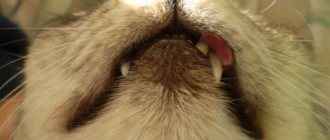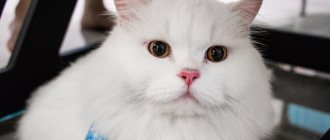Corneal ulcers in cats are often caused by trauma or burns. This is an extremely dangerous disease that develops rapidly and leads to complete blindness. Therefore, it is important to consult a veterinarian in time. Therapy is carried out depending on the degree of eye damage. Medicines and surgery are used. In the worst case, the diseased eye is completely removed.
Causes
A cat's eye is a delicate structure that can be damaged by external influences.
An ulcer can develop in 2 directions - infectious and non-infectious.
Non-infectious factors for the onset of the disease include:
- Injury.
- Breed predisposition - most often in brachycephalic cat breeds (Persian, exotic, Himalayan, etc.).
- Turning of the eyelids.
- Incorrect growth of eyelashes, which constantly injure the cornea when blinking.
- Entry of a foreign body.
- Dry eye syndrome.
- Decreased local immunity.
- Chemical burns to the eyes.
The infectious nature of the occurrence can be caused by both bacteria, viruses and fungi. Most often, the eye is subject to inflammation due to staphylococcal, streptococcal infections, Pseudomonas aeruginosa, corona and herpevirus, as well as chlamydia. This type of ulcer has a long and severe course, is prone to relapse and is difficult to treat.
Predisposing factors
There are several reasons for the development of corneal ulcers in animals. Eye injuries are most often to blame . In particular, a cat can “plant” its own eye when washing itself (especially if it has a split claw); grass stubble can stick into the cornea. The second most common cause is a chemical burn to the cornea . This can happen when components of household chemicals, fertilizers, and other chemicals get into the eyes. However, in some cases there is no need to talk about “ulcers” here: especially aggressive chemicals “simply” burn out the cat’s eye. So keep chemicals away from your pets (and children)! What other reasons for the development of the disease exist?
Despite popular belief, viral, bacterial and fungal infections rarely cause corneal ulcers in cats. But still, this possibility should not be completely excluded. In addition, today experts believe that an infectious corneal ulcer is almost never a primary disease. Much more often, this is only a consequence of the introduction of pathogenic microflora from a source of inflammation already present in the animal’s body.
Development of the disease - pathogenesis
A healthy cat's eye has 4 layers of cornea. The outer layer is represented by multilayer epithelium, which mechanically protects the organ of vision of animals. Below is a kind of framework - the stroma, which consists of collagen fibers and has the greatest thickness among all layers of the cornea.
Under it there is a membrane, which is a “guard” against the penetration of harmful flora. The innermost layer is the endothelium; it is needed to maintain the water balance of the eye. The main function is to remove excess fluid to maintain the transparency of the entire cornea and prevent edema. Does not have the ability to recover from damage.
If only the outer epithelium is damaged, then the body copes with the injury on its own, “healing” the defect within a few hours. However, when a microorganism enters the eye tissue, toxins and waste products of pathogenic flora begin to be released. These substances deepen the lesion, melting the tissue and causing perforation of the cornea, as well as the introduction of infection into the deeper layers.
Forecast
Timely treatment allows you to preserve vision and prevent complications. During treatment, fluorescein tests are carried out, the results of which determine the degree of healing. Superficial forms epithelialize within 4-5 days. The healing time for deep defects varies from person to person (usually 3-4 weeks). The main factor influencing the recovery period is the treatment of the underlying disease that caused ulcerative keratitis. When it is eliminated, regenerative processes are accelerated.
In our clinic, a doctor is an ophthalmologist, a doctor of the highest category, A. E. Kopenkin .
Symptoms
The disease varies in severity of symptoms, depending on the presence of the pathogenic agent and the presence of complications.
The main features include:
- At the initial stages, narrowing of the palpebral fissure, swelling, hyperemia and lacrimation occurs.
- A sharp pain appears in the eye, the animal often shakes its head and scratches the damaged eye with its paw.
- Photophobia and constant squinting.
- Subsequently, the ulcer penetrates into deeper layers, which are not painful when damaged due to weak innervation, and the initial symptoms of inflammation disappear. Purulent or mucous discharge appears.
- The characteristic appearance of the cornea is one cloudy and swollen.
Seeing the ulcer itself at home is possible only in advanced cases with a perforated ulcer.
Based on etiological characteristics, three types of ulcers are distinguished:
- Purulent - occurs when there is a bacterial infection with abundant purulent discharge from the eyeball.
- Perforated - a complicated course, with penetration into the deep layers of the cornea.
- Creeping - occurs when infected with staphylococcus or streptococcus, quickly occupies a vast territory.
What to do if your cat's eye is cloudy
Eye pathologies in cats are not uncommon. But there are certain eye diseases in these pets that carry the risk of partial or even complete loss of vision. One of the main signs of this condition is clouding of the cat's eye.
Relevance of the problem
If a cat's eye becomes cloudy, it appears as if he is blind. But it is not always the case. To determine the true cause of blurred vision in a pet, you need to contact a veterinarian-ophthalmologist.
The fact is that the causes of this eye pathology can be various diseases: cataracts, keratitis, glaucoma, uveitis. They can only be recognized in a veterinary clinic using special equipment.
Causes of the disease
lens pathology. They are limited to clouding of the pupil, the cornea is not affected and remains transparent. When you shine light on the eye, the cloudiness narrows, which confirms the lesion is in the pupil.
Causes of loss of transparency of the cornea of the eye, symptoms, diagnosis, treatment
The opacity of the cornea of the eye indicates its disease. There are 3 groups of reasons that provoke the occurrence of problems with the cornea:
With this disease, vision always deteriorates or is completely lost. Keratitis is a consequence of toxic liver damage due to poisoning and intoxication, acute infectious eye diseases caused by bacteria, viruses, fungi, or neurogenic pathologies.
The first symptoms of keratitis are redness of the eye and the presence of serous or purulent discharge. After some time, the cat’s eye becomes cloudy and the cornea loses its transparency. With prolonged development of the pathology, ulcers and necrosis of the cornea develop.
To select adequate treatment, reliable diagnosis is necessary. It is carried out with
Source
Diagnostics
You should not diagnose a corneal ulcer on your own. It is almost impossible to do this at home without special equipment. Therefore, when the first signs of eye disease appear, it is important to immediately contact a veterinarian in order to begin treatment in a timely manner and preserve your pet’s vision and the organ itself.
One of the simplest diagnostic methods is to instill a special fluorescent solution - fluorescein - into the conjunctival sac. After this, the condition of the cornea is assessed under the light of a slit lamp. In this case, defects on the surface, as well as the extent of the lesion, will be clearly visible. Also, this test can determine the depth of the ulcer, the condition of the cornea itself and the smallest erosions.
As additional research, to detect the causes of the disease and concomitant diseases and complications, the following is carried out:
- Schirmer test - performed to diagnose dry eye syndrome. The test is carried out using express strips that determine the amount of tear fluid.
- Measuring intraocular pressure using a non-contact method - using a computer that determines the response of the cornea to an air stream.
- Bacterioscopy is carried out from material taken from the ulcer itself. Helps to accurately identify the pathogen and prescribe adequate treatment.
A little about complications
Can a mild ophthalmic disease (for example, serous conjunctivitis) “mutate” into a corneal ulcer? Yes. That is why, if you have any eye problems, you should immediately take your pet to an experienced veterinarian. Unfortunately, this development of events is especially likely in cases where the owners try to “treat” their pet on their own. As a rule, this does not lead to anything good. Moreover, even in situations where a cat is being treated by a veterinarian, the animal must visit him for preventive purposes not only during the immediate therapeutic period, but also after (at least once a week, for two weeks). If a specialist regularly monitors your pet’s condition, he will be able to notice threatening signs in time.
How likely is it to develop side effects? This possibility exists, but cases are still relatively rare. Unfortunately, with a corneal ulcer, the side effects are not always obvious - the cat is already feeling bad in the first days, so sometimes even experienced breeders miss warning signs. You should be alerted, for example, to a clearly deteriorating condition of the animal immediately after taking the drugs. If this occurs, its use should be discontinued immediately and your veterinarian should be contacted immediately.
Treatment
A corneal ulcer is a serious disease that leads to dangerous complications and can lead to removal of the eye. Therefore, you should definitely consult a doctor to make an accurate diagnosis, since an incorrect interpretation of symptoms can lead to an incorrect diagnosis and, accordingly, irrational treatment, which leads to a worsening of the condition.
Therapy depends on the causes that caused the disease and the pathogenic flora. During treatment, you should limit your pet's physical activity and good, nutritious food. To avoid self-injury to the eye, a special collar is used.
Ulcers caused by bacteria require powerful antibiotic therapy. They are dripped locally, 6 times during the day. I usually use drops with a broad spectrum of action - ciprovet, Vigamox, iris, chloramphenicol, terramycin. To ensure long-term contact with the antibiotic (most often at night), ointments are used that are placed in the conjunctival sac - streptomycin.
Conservative therapy is suitable for a small defect that resolves without melting the cornea. In case of extensive damage, surgical intervention is possible. To do this, the bottom and edges of the ulcer are cleaned of necrotic tissue and the eye is covered with a special apron, which is formed from the third eyelid. It is also possible to simply stitch the edges of the eyelids.
After the operation, I prescribe systemic antibiotics - fluoroquinolones, penicillins, antibacterial drops into the conjunctival sac. The stitches are removed after 2 weeks. At the site of the ulcer, a scar should form, manifested as fibrosis of the cornea.
For viral cases, antiviral drops are used - trifluridine, idoxuridine. Prescribed daily until clinical signs disappear every 4 hours. Then the dosage is gradually reduced, continuing the course for 2 weeks. It is also advisable to use immunostimulating drugs.
If the cause is a foreign body or eyelashes, then they are removed immediately, even before treatment begins, in order to remove the provoking factor.
Under no circumstances should you use hormonal anti-inflammatory ointments and drops. They can lead to the spread of inflammation.
A modern surgical method for treating extensive ulcers is the transplantation of an artificial corneal graft.
With this they read:
Keratitis in dogs is a disease that is characterized by inflammation of the cornea of the eye, as a rule, has a pronounced symptomatic picture and must be diagnosed in order to prescribe the correct treatment.
Anatomy, hygiene, and other related factors often contribute to the development of eye problems throughout your pet's life. Diseases such as conjunctivitis can be treated quite quickly, but in some cases only a qualified veterinary ophthalmologist can help the animal
Cataracts in dogs are a common ophthalmological disease that worsens a dog’s vision and can also cause complete blindness. Cataracts in dogs are clouding of the lens, which prevents the passage of light into the eye.
One of the most common eye diseases in dogs is conjunctivitis. This is an inflammatory process that develops in the mucous membrane of the eyes. The danger of the pathology lies in the difficulty of treatment after transition to a chronic form.
Excessive tearing, redness of the eyes and swelling of the eyelids in a cat may be a manifestation of a disease such as conjunctivitis. This is a disease manifested by inflammation of the conjunctiva.
Entropion of the eyelid is a fairly serious eye pathology in cats, often requiring surgical intervention. With this pathology, the eyelid in one or both eyes bends in the opposite direction, touching the mucous membrane with the skin surface and hair.
Entropion of the eyelids is more common in dogs than in cats. This pathology is characterized by an inward bend of the eyelid and irritation of the eye mucosa. While not a life-threatening condition, the disease can lead to undesirable consequences, including loss of an eye, if left untreated.
Chronic keratoconjunctivitis that develops due to autoimmune disorders in dogs is called pannus. The disease affects the limbus and cornea. The infiltrate that forms over time under the cornea is replaced by scar tissue, which leads to vision deterioration and even loss.
Even novice breeders know very well that only a truly healthy animal can have clear, clean and shiny eyes. If some kind of dubious exudate appears on them, the eyes fade and become cloudy, you need to urgently show your pet to a veterinarian. The fact is that ophthalmological diseases and corneal ulcers in cats, in particular, lead to extremely unpleasant consequences, often ending in complete blindness of the animal.
Videos and Illustrations
Clinical case: Sphynx kitten, corneal ulcer
Viral tree canker
Deep corneal ulcer
Purulent panophthalmitis - a complication of a perforated ulcer
Extensive purulent corneal ulcer before staining
Perforated corneal ulcer
Ulcer after staining
Ulcer with fluorescent staining
Products for daily cat eye care
Ciprovet drops can be used to care for the eyes of cats.
To ensure that cats do not have problems with their eyes, they should be constantly looked after, and for some breeds, regular eye washing is simply necessary. To do this, use special products for animals.
Rinse drops are used as follows:
- drop 1-2 drops of the drug into each eye;
- Gently massage the cat's eyelids;
- Remove the preparation with a clean cotton pad;
- carry out the procedure twice a day.
Use lotions to remove tear tracks. They are applied to a cotton pad and gently wiped over the hair around the eyes. This procedure should be done once a day for a week. If necessary, the course is repeated.
Here are the most popular drops and lotions for cat eye care:
- Diamond Eyes (drops);
- BEAPHAR Oftal (drops);
- BEAPHAR Sensitiv (lotion);
- Bars (lotion);
- Tsiprovet et al.

